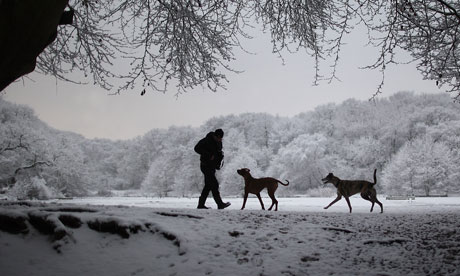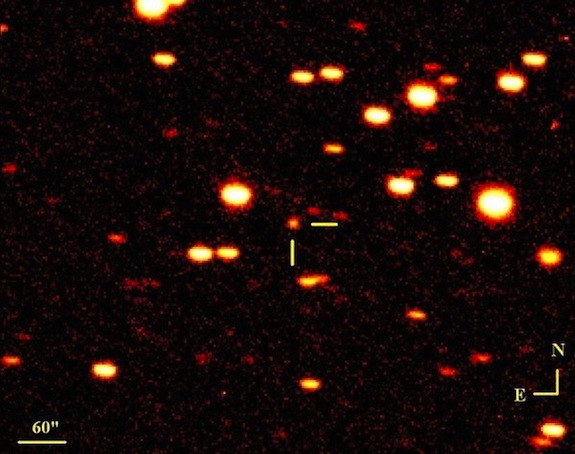We're lucky to be enjoying a brief, balmy interglacial. Watch out when it stops!
We're enjoying a relatively long and stable period of pleasant weather at the moment. And by that, I don't mean the past few years or decades. I mean the past 12,000 years or so. For around 2.6m years, the Earth has experienced a fluctuating climate, swinging between icy glaciations and warm interglacials. It's an uneven division, with glaciations lasting around 100,000 years, and interglacials just 10,000 to 15,000. So just imagine the impact on plants and animals of these switches from long, wintry glaciations to brief, summery interglacials. The differences in climate are extreme. At the peak of the last ice age, just 20,000 years ago, vast ice sheets descended over the northern parts of Europe and North America. For any animals adapted to a temperate climate, glaciations posed something of a challenge. Hibernation and woolly jumpers would not be enough to ride out 100,000 years of winter. Those warm-loving animals (and humans) cleared out of the north and sought refuge in the south.
|  |
A Newly Discovered Comet Is Headed Our Way
Last Friday, a pair of Russian astronomers, Artyom Novichonok and Vitaly Nevski, were poring over images taken by a telescope at the International Scientific Optical Network (ISON) in Kislovodsk when they spotted something unusual. In the constellation of Cancer was a point of light, barely visible, that didn’t correspond with any known star or other astronomical body.
Their discovery—a new comet, officially named C/2012 S1 (ISON)—was made public on Monday, and has since made waves in the astronomical community and across the internet. As of now, Comet ISON, as it’s commonly being called, is roughly 625 million miles away from us and is 100,000 times fainter than the dimmest star that can be seen with the naked eye—it’s only visible using professional-grade telescopes. But as it proceeds through its orbit and reaches its perihelion, its closest point to the sun (a distance of 800,000 miles) on November 28th, 2013, it could be bright enough to be visible in full daylight in the Northern Hemisphere, perhaps even as bright as a full moon. |  |
Where’s My Clone-o-saurus?

Seeing a hadrosaur alive would be a fantastic sight. Or any non-avian dinosaur, for that matter. As lovely as today’s avian dinosaurs are, it’s their distant, extinct cousins that fire my imagination. Sadly, despite the speculations of theoretical physicist Michio Kaku, I don’t think my dinosaur dreams are going to come true.
In a Big Think video posted last week, Kaku rhapsodized about the possibility of resurrecting extinct species through genetic techniques. I’m not as optimistic as he is, especially since Kaku glosses over some essential steps in his confused editorial.
In a Big Think video posted last week, Kaku rhapsodized about the possibility of resurrecting extinct species through genetic techniques. I’m not as optimistic as he is, especially since Kaku glosses over some essential steps in his confused editorial.
Tiny fossils hint at effects of ocean acidification
A rare find of stunningly intact fossils of prehistoric plankton will allow researchers to study how the tiny marine organisms cope with rising acidity in the oceans.
Finding such intact specimens of coccolithophores, micrometre-sized marine plankton encased in discs of calcium carbonate, is a real coup — searching for fossils of calcified single-celled organisms often yields only skeletal bits that have fallen to the ocean floor. “Breaking open undisturbed 56-million-year-old sediment samples, we can image coccolithophores — right down to their intracellular vesicles — using a scanning electron microscope,” said Paul Bown, a palaeoceanographer at University College London, who this week presented images of the fossils at the Third International Symposium on the Ocean in a High CO2 World in Monterey, California. |  |
Sun's Shock Waves May Have Staggered Solar System's Planet Formation
Our solar system's planets may have formed at differing times, determined by shock waves flowing from the young sun, one astronomer suggests.
This theory posits that Earth is one of the youngest planets in the solar system, along with Mercury, Venus and Mars. In a new paper, Tagir Abdylmyanov, an associate professor from Kazan State Power Engineering University in Russia, describes his idea and suggests it presents a possible new way of predicting where planets will form in young star systems. |  |
Mars Sample-Return Goal Drives NASA's Exploration of Red Planet
The next steps in NASA's Mars exploration strategy should build toward returning Martian rocks and dirt to Earth to search for signs of past life, a new report by the space agency's Red Planet planning group finds.
The report, released today (Sept. 25) by the Mars Program Planning Group (MPPG), lays out a series of options that NASA could employ to get pieces of the Red Planet in scientists' hands here on Earth. The space agency is now mulling those options and could announce its chosen path by early next year, when the White House releases its proposed budget for fiscal year 2014. |  |
Why 'Super-Earth' Alien Worlds May Be Unlikely to Support Life
So-called "super-Earth" alien worlds may bear little resemblance to our own home planet and thus could be less likely to support life than previously believed, a new study suggests.
Super-Earths — alien planets bigger than Earth, but containing less than 10 times its mass — may be undifferentiated hunks of rock, possessing neither a mantle nor a core, researchers found. Super-Earths may also lack magnetic fields, which help protect life on our planet by shielding it from harmful radiation. |  |
Space surgery possible with zero-gravity tool
DRAINING an infected abscess on Earth is a straightforward procedure. On a spaceship travelling to the moon or Mars, it could kill everyone on board.
Blood and bodily fluids cannot be contained in zero gravity, which means there is currently no way to perform surgery in space without contaminating the cabin. This makes an extended stay problematic, says James Antaki at Carnegie Mellon University in Pittsburgh, Pennsylvania. "Based on statistical probability, there is a high likelihood of trauma or a medical emergency on a deep space mission," he says. |  |
Ice may lurk in shadows beyond Moon's poles
Water ice on the moon may be more widespread than previously thought. Permanent shadows have been spotted far from the lunar poles, expanding the number of sites that would be good candidates for exploration by robotic rovers — or even for the locations of lunar bases.
Researchers have known for decades that the Moon's poles host craters with lofty rims that shield their floors from sunlight, so searches for shadowed areas harbouring water ice have focused on the poles1, 2. But over the past few months, researchers have built a catalogue of permanently shadowed regions elsewhere on the Moon. |  |
"Vampire Squid from Hell" turns out it's the only known nonpredatory squid

Despite its ghoulish name and looks, the vampire squid (pictured, an individual in 2004) isn't a bloodthirsty terror of the deep after all, a new study says.
Instead, the nightmarishly named species browses on "marine snow"—dead plankton, algae, fecal matter, goo, shells shed by tiny crustaceans, and other detritus.
The squid gather the food particles using two long, hair-lined filaments before wrapping the bits into meal-size mucus balls, according to undersea video footage, live lab observations of captive vampire squid, autopsies, and examination via electron microscope.
Instead, the nightmarishly named species browses on "marine snow"—dead plankton, algae, fecal matter, goo, shells shed by tiny crustaceans, and other detritus.
The squid gather the food particles using two long, hair-lined filaments before wrapping the bits into meal-size mucus balls, according to undersea video footage, live lab observations of captive vampire squid, autopsies, and examination via electron microscope.
Demolishing Heisenberg with clever math and experiments
Heisenberg's uncertainty principle turns up everywhere in quantum mechanics. The idea is that certain types of measurements like position and momentum are paired. By measuring one of the pair, we generate uncertainty in the other. This is also referred to as quantum back-action: the thing you are measuring pushes back on the measuring system, which generates uncertainty in some other property. This fundamental idea has some serious consequences when it comes to measuring very small stuff, like gravitational waves.
|  |
ACLU forces government to reveal skyrocketing surveillance stats
Statistics obtained by the American Civil Liberties Union provides additional evidence that government surveillance of Americans has skyrocketed in recent years. The government is legally obligated to release reports about its surveillance activities, but it refused to do so until the ACLU sued to compel the production of the documents.
The reports concern what lawyers call "pen register" and "trap and trace" records. These terms originally referred to hardware devices law enforcement could attach to the phone network to capture information about (but not the contents of) phone calls. Pen registers recorded outgoing phone numbers. Trap and trace devices recorded incoming phone numbers. |  |
Neanderthals & humans co-existed in Middle Eastern caves and interbred
Neanderthals may have lived side by side with early humans and possibly interbred with them, according to new research.
Stone axes and sharp flint arrowheads of both branches of the human race have been discovered in limestone caves in northern Israel. The findings, reported in the Times, have led archeologists to believe the two sub-species found harmony in a coastal mountain range that today is in a state of war with its neighbours. None of the bones uncovered at Nahal Me'arot - a World Heritage site - had lethal wounds which suggested prehistoric men lived in peace with each other 80,000 years ago. |  |
Is 'Looper'-like Time Travel Possible? Scientists Say Maybe

Time travel is a staple of science fiction, with the latest rendition showing up in the film "Looper." And it turns out jumps through time are possible, according to the laws of physics, though traveling into the future looks to be much more feasible than traveling into the past.
"Looper" stars Joseph Gordon-Levitt as Joe, an assassin who kills targets sent back in time by the mob. Things get complicated when Joe is assigned to kill his future self, played by Bruce Willis. The movie, produced by TriStar Pictures, opens today (Sept. 28).
In this imagining, time travel has been put to nefarious uses by people operating outside the law. But could such a thing ever happen in real life?
"It's actually consistent with the laws of physics to change the rate at which clocks run," said Edward Farhi, director of the Center for Theoretical Physics at MIT. "There's no question that you can skip into the future".
"Looper" stars Joseph Gordon-Levitt as Joe, an assassin who kills targets sent back in time by the mob. Things get complicated when Joe is assigned to kill his future self, played by Bruce Willis. The movie, produced by TriStar Pictures, opens today (Sept. 28).
In this imagining, time travel has been put to nefarious uses by people operating outside the law. But could such a thing ever happen in real life?
"It's actually consistent with the laws of physics to change the rate at which clocks run," said Edward Farhi, director of the Center for Theoretical Physics at MIT. "There's no question that you can skip into the future".
Pictures: New-Species "Heaven" Discovered in Peru

A new species of night monkey (pictured) is one of eight new mammals found during an expedition to northern Peru's Tabaconas Namballe National Sanctuary (map), scientists announced recently.
A team of Mexican and Peruvian biologists found this "new heaven of unknown biodiversity" during a 2009-2011 expedition, according to a press statement.
Rarely seen and little-studied, night monkeys are listed as vulnerable by the International Union for Conservation of Nature (IUCN) and endangered by the Peruvian government, making the new discovery especially notable.
A team of Mexican and Peruvian biologists found this "new heaven of unknown biodiversity" during a 2009-2011 expedition, according to a press statement.
Rarely seen and little-studied, night monkeys are listed as vulnerable by the International Union for Conservation of Nature (IUCN) and endangered by the Peruvian government, making the new discovery especially notable.
Component of chocolate and wine enhances memories -- in snails
A component of chocolate, wine and green tea can enhance memories -- in snails, at least.
A new study, released Wednesday in the Journal of Experimental Biology, showed that modest concentrations of the flavonoid epicatechin caused snails' memories to last longer and be harder to overwrite. In nature, flavonoids are found in many species of plants, often adding color to plant skin by serving as pigments. |
Big Quakes Signal Changes Coming To Earth's Crust
On April 11 of this year, an extraordinary cluster of earthquakes struck off Sumatra. The largest shock, magnitude 8.7, produced stronger ground-shaking than any earthquake ever recorded. And it surprised seismologists by triggering more than a dozen moderate earthquakes around the world.
The quakes are also a sign of big changes to come in the Earth's crust. |  |
UFO hunters: They are still watching
A group of British UFO-watchers is celebrating 50 years of searching for spacecraft in the sky. What keeps them looking for extra-terrestrial life?
There are no windows in the functional-looking basement hall beneath a north London hotel. But everyone gathered here is gazing to the heavens. Figuratively speaking, that is. The annual conference of the British UFO Research Association (Bufora), is a gathering of enthusiasts for unexplained aerial phenomena that might, they speculate, be evidence of extra-terrestrial intelligence. |  |
'Vatileaks': evidence of top-secret Papal inquiry to be withheld from court
It was the start of a trial which has all the elements of a Dan Brown novel and threatens to lift the lid on power struggles and skulduggery at the very heart of the Roman Catholic Church.
The central question, as in all good thrillers: did the butler do it? The Pope's butler appeared in a Vatican court for the first time yesterday to face charges that he stole confidential and compromising documents, some of them allegedly from the desk of Benedict XVI himself. |  |


No comments:
Post a Comment